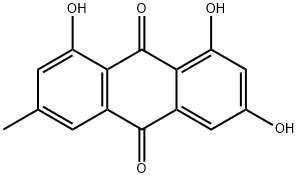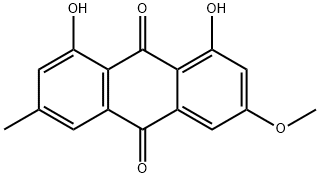Emodin
- CAS No.
- 518-82-1
- Chemical Name:
- Emodin
- Synonyms
- RHUBARB EXTRACT;EMODOL;EMODINE;1,3,8-TRIHYDROXY-6-METHYL-9-10-ANTHRACENEDIONE;Ecdyson;1,6,8-Trihydroxy-3-Methylanthraquinone;Emdin;EMODIN;Archin;EMODIN 99
- CBNumber:
- CB2258856
- Molecular Formula:
- C15H10O5
- Molecular Weight:
- 270.24
- MDL Number:
- MFCD00001207
- MOL File:
- 518-82-1.mol
- MSDS File:
- SDS
| Melting point | 255 °C (dec.)(lit.) |
|---|---|
| Boiling point | 373.35°C (rough estimate) |
| Density | 1.3280 (rough estimate) |
| refractive index | 1.5000 (estimate) |
| storage temp. | 2-8°C |
| solubility | DMSO: soluble |
| form | powder |
| pka | 6.39±0.20(Predicted) |
| color | orange |
| Water Solubility | <0.1 g/100 mL at 19 ºC |
| Merck | 14,3561 |
| BRN | 1888141 |
| InChIKey | RHMXXJGYXNZAPX-UHFFFAOYSA-N |
| LogP | 3.641 (est) |
| CAS DataBase Reference | 518-82-1(CAS DataBase Reference) |
| NCI Dictionary of Cancer Terms | emodin |
| FDA UNII | KA46RNI6HN |
| EPA Substance Registry System | Emodin (518-82-1) |
SAFETY
Risk and Safety Statements
| Symbol(GHS) |  GHS07 |
|||||||||
|---|---|---|---|---|---|---|---|---|---|---|
| Signal word | Warning | |||||||||
| Hazard statements | H302 | |||||||||
| Precautionary statements | P264-P270-P301+P312+P330-P501 | |||||||||
| Hazard Codes | Xi | |||||||||
| Risk Statements | 36/37/38 | |||||||||
| Safety Statements | 26-36-37/39-36/37 | |||||||||
| WGK Germany | 3 | |||||||||
| RTECS | CB7920600 | |||||||||
| F | 8-10-23 | |||||||||
| HS Code | 29146990 | |||||||||
| NFPA 704 |
|
Emodin price More Price(51)
| Manufacturer | Product number | Product description | CAS number | Packaging | Price | Updated | Buy |
|---|---|---|---|---|---|---|---|
| Sigma-Aldrich | 30269 | Emodin analytical standard | 518-82-1 | 10mg | $417 | 2024-03-01 | Buy |
| Sigma-Aldrich | 1235059 | Emodin United States Pharmacopeia (USP) Reference Standard | 518-82-1 | 30mg | $406 | 2024-03-01 | Buy |
| TCI Chemical | E0500 | Emodin >96.0%(HPLC) | 518-82-1 | 1g | $484 | 2024-03-01 | Buy |
| TCI Chemical | E0500 | Emodin >96.0%(HPLC) | 518-82-1 | 100mg | $98 | 2024-03-01 | Buy |
| Alfa Aesar | J61600 | Emodin | 518-82-1 | 100mg | $135.65 | 2024-03-01 | Buy |
Emodin Chemical Properties,Uses,Production
Physical and chemical properties
Emodin, also known by the Chemical name 1, 3, 8-trihydroxy-6-methyl-anthraquinone with a molecular formula of C15H10O5 and a molecular weight of 270.24, exists in the form of free emodin or emodin glycosides in rhizomes and roots of Rheum palmatum L, Rheum officinale Baill, and Rheum tanguticum Maxim. ex Balf. in the family Polygonaceae. In a form of orange-yellow crystals of melting point of 256-257℃ that can sublimate under a vacuum of 1,600 Pa, the compound is soluble in ethanol, sodium hydroxide, sodium carbonate and aqueous ammonia, slightly soluble in ether, chloroform, carbon tetrachloride and benzene, and almost insoluble in water. Its form as emodin triacetate is yellow crystals of melting point of 197℃, and the form of emodin 3-methyl ether (also known as physcion) is dark-red needle crystals of melting point of 207 ℃. The compound can be obtained by chemical synthesis or by extraction from plants.
Aloe-emodin is one of the main components of aloe essential oil, present in the form of aloe-emodin in aloe, or present in the form of glycosides in rhubarb, senna and aloe.
Chemical properties
Orange needles of melting point of 256-257℃ (259-260℃); soluble in alcohol, slightly soluble in ether, chloroform and benzene, and insoluble in water. The solution color would become cherry red when it is dissolved in aqueous caustic solutions, aqueous solution of sodium carbonate or ammonia solution.
Uses
1. The product can be used as a laxative. As it is susceptible to oxidative damage within the body, its diarrhea activity is actually very weak. However, it can be compounded with glucose to form a glycoside with diarrhea activity. Both emodin-1-O-β-D-glucoside and emodin-8-O-β-D-glucoside are glycosides formed through combination of emodin and glucose. The only different between the two are the binding sites. The two glycosides coexist in Radix et Rhizoma Rhei.
2. intermediate;health products material.
Radix et Rhizoma Rhei
Radix et Rhizoma Rhei is the dry root or rhizome of Rheum palmatum L, Rheum officinale Baill, and Rheum tanguticum Maxim. ex Balf. in the genus Rheum of the family Polygonaceae. Rheum tanguticum Maxim. ex Balf has slender pinnate leaves with three deep lobes and dense inflorescence branches, often erect, clinging to the stem, which are the main difference of it from Rheum palmatum L. The main difference between Rheum tanguticum Maxim. ex Balf. and the other two species mentioned above are its lobed leaves with big serrate or broadly triangular margin, large and yellow-white flowers, oval-shaped flower buds and patulous branches. There are about 60 Rheum species all over the world, of which about 50 are in China.
Morphological Characteristics: herbaceous perennial about two meters high. Rhizomes and roots are fleshy and yellowish-brown in color. The stem is erect, smooth, hairless and hollow. The basal leaf has a fleshy, long and sturdy petiole, about as long as the leaf blade. The leaf blade is broadly ovate or nearly round in shape, up to 40 cm in diameter, palmate-cleft with three to five (or to seven) lobes and each lobe sometimes also palmate-cleft or serrate. The leaf base is slightly heart-shaped. The stem leaf is small, shortly stalked. The ocrea is membranous and densely pubescent.
Habitat and distribution: Grow in mountain areas, forest margins or grassland, wild or cultivated and distributed in Shaanxi, southeastern Gansu, Qinghai, western Sichuan, northwestern Yunnan and Eastern Tibet.
Cultivation: suitable for growing in places with cool and moist climate and with deep soil layer that contains humus-rich sandy loam or calcareous loam, rather than growing in cold places with high temperature and humidity.
Harvest: harvest during September to October, select plants that have grown more than three years, dig up the rhizomes and roots, remove the leaves, stems, rootlets, scrape the bark and buds, and then dried in air or in an oven, or sliced and dried.
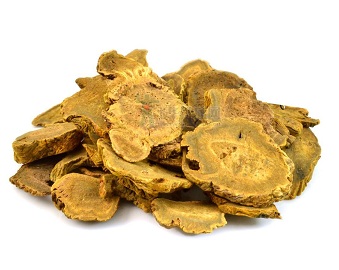
Figure 1 is an image of the Radix et Rhizoma Rhei
Chemical constituents
There have been more than 130 compounds isolated and characterized from a variety species of Rheum, including anthraquinones and anthraquinone glycosides, anthrones, bianthrones and bianthrone glycosides, stilbenes and stilbene glycosides, gallate, naphthalene derivatives, chromanones and chromanone glycosides, banzylethylketone, tannins and so on. Among them the anthraquinones are the most important and representative ingredients. Free anthraquinones mainly include rhein, emodin, physcion, aloe-emodin, and chrysophanol. And anthraquinone glycosides mainly include chrysophanol-1-glucoside, chrysophanol-8-glucoside, emodin-1-glucoside, emodin-8-glucoside, physcion-8-glucoside, physcion-8-gentiobiosiden, aloe-emodin-8-glucoside, aloe-emodin-3-glucoside, and rhein-8-glucoside. Bianthrone glycosides include sennosides A, B, C, D, E, and F. Stilbenes and stilbene glycosides include rhaponticin, rhapontigenin and de-oxyrhaponticin.
Radix et Rhizoma Rhei contains a variety of tannins, both hydrolyzable tannins and condensed tannins[4]. Hydrolyzable tannins and its related compounds contain a variety of pentagalloylglucose and 1-O-galloyl-6-O-cinnamoyl-β-D-glucose. Condensed tannins and its related compounds contain catechin, epicatechin and its polymers. In addition, Radix et Rhizoma Rhei also contains a variety of banzylethylketone glycosides.
Production method
Emodin is a plant laxative widely present in plant organs such as roots of Radix et Rhizoma Rhei, bark and root bark of buckthorn and cassia seeds. Emodin can be extracted from roots and rhizomes of Radix et Rhizoma Rhei. It also can be obtained by synthesis, for example, using 2-methyl-anthraquinone, or 3, 5-nitro-phthalic anhydride and m-cresol as the raw material.
Antitumor effect
Pharmacological studies have found that anthraquinone derivatives in Radix et Rhizoma Rhei, rhein, emodin and aloe-emodin showed obvious inhibitory effect on cancers, especially on cancers such as melanoma, P388 leukemia and Ehrlich ascites carcinoma. The polysaccharides contained in Radix et Rhizoma Rhei could markedly inhibit the cells of sarcoma S180. And a concentration of 10 μg/ml emodin could reduce the maximum growth density and the mitotic index of human lung cancer cell line A-549, and apparently decreased the incorporation of tritiated thymidine and the level DNA content. It was also found that the drug could relatively increase the number of cells at the G1 and S stages and decreased the number of aneuploid cells as well as the number of cells at the G2/M phase, with a sinistral displacement of the peak in the DNA histogram. These results suggested that emodin has an obvious inhibitory effect on human lung cancer A-549 cells. The antitumor mechanism of Radix et Rhizoma Rhei is presently considered to be the inhibition of respiration and DNA biosynthesis of cancer cells. It is also believed that rhein and emodin may destroy the cancer cells directly.
Diuretic effect
Both rhein and emodin have evident diuretic effect. The urine volume increased to peak two to four hours after dosing, and in the meanwhile the amounts of Na+ and K+ discharges were also reached to the peak. Aloe-emodin and chrysophanol were less effective in diuretic property as compared with rhein and emodin. The mechanism is contributed to the inhibitory effect of rhein and emodin on renal medullary Na+, K+-ATPase. The Na+ re-absorption in renal tubules is mainly active transport which needs energy from ATP hydrolysis catalyzed by the Na+, K+-ATPase. When the enzyme is inhibited, Na+ re-absorption would decrease because of insufficient energy supply, which leads to water discharge increase along with the increase of Na+ discharge. When distal convoluted tubule Na+ increases, promote Na+-K+ exchange would be promoted, resulting in increase in K+ discharge.
Chemical Properties
red-orange powder
Uses
antibacterial, antineoplastic, cathartic, tyrosine kinase inhibitor
Uses
Emodin has been used:
- to investigate its regulatory mechanisms on lipopolysaccharide (LPS)-induced inflammatory injury in myocarditis
- as a reference standard for the development and validation of high performance liquid chromatography (HPLC)-photodiode array (PDA) assay method
- to inhibit Tau aggregation
- for direct binding assay
Uses
Occurs mostly as the rhamnoside (see Frangulin) in rhubarb root. Cathartic.
Definition
ChEBI: Emodin is a trihydroxyanthraquinone that is 9,10-anthraquinone which is substituted by hydroxy groups at positions 1, 3, and 8 and by a methyl group at position 6. It is present in the roots and barks of numerous plants (particularly rhubarb and buckthorn), moulds, and lichens. It is an active ingredient of various Chinese herbs. It has a role as a tyrosine kinase inhibitor, an antineoplastic agent, a laxative and a plant metabolite. It is functionally related to an emodin anthrone. It is a conjugate acid of an emodin(1-).
General Description
Orange needles or powder.
Air & Water Reactions
Insoluble in water.
Reactivity Profile
Emodin may be sensitive to prolonged exposure to light. Probably a weak acid due to the phenolic functional groups.
Health Hazard
ACUTE/CHRONIC HAZARDS: When heated to decomposition Emodin emits acrid smoke and irritating fumes.
Fire Hazard
Flash point data for Emodin are not available; however, Emodin is probably combustible.
Biological Activity
Naturally occurring anthraquinone that displays a range of biological activities. Exhibits anti-inflammatory, antitumor and neuroprotective effects.
Biochem/physiol Actions
Cell permeable: yes
Purification Methods
Archin forms orange needles from EtOH, Et2O, *C6H6, toluene or pyridine. It sublimes above 200o at 12mm. [Tutin & Clewer J Chem Soc 99 946 1911, IR: Bloom et al. J Chem Soc 178 1959, UV: Birkinshaw Biochem J 59 495 1955, Raistrick Biochem J 34 159 1940.] 1R,2S-(-)Ephedrine see (-)-ephedrine (1R,2S-2-methylamino-1-phenylpropanol) in “Miscellaneous” in Chapter 6.
Emodin Preparation Products And Raw materials
Raw materials
1of2
Preparation Products
| Supplier | Tel | Country | ProdList | Advantage | |
|---|---|---|---|---|---|
| Changsha Staherb Natural Ingredients Co., Ltd. | +86-0731-84213302 +8618374838656 | sales@staherb.cn | China | 1025 | 58 |
| Shanghai Affida new material science and technology center | +undefined15081010295 | 2691956269@qq.com | China | 359 | 58 |
| Springchem New Material Technology Co.,Limited | +86-021-62885108 +8613917661608 | info@spring-chem.com | China | 2068 | 57 |
| Henan Tianfu Chemical Co.,Ltd. | +86-0371-55170693 +86-19937530512 | info@tianfuchem.com | China | 21695 | 55 |
| Hangzhou FandaChem Co.,Ltd. | 008657128800458; +8615858145714 | fandachem@gmail.com | China | 9353 | 55 |
| Nanjing ChemLin Chemical Industry Co., Ltd. | 025-83697070 | product@chemlin.com.cn | CHINA | 3012 | 60 |
| Nanjing Finetech Chemical Co., Ltd. | 025-85710122 17714198479 | sales@fine-chemtech.com | CHINA | 885 | 55 |
| Shanghai Zheyan Biotech Co., Ltd. | 18017610038 | zheyansh@163.com | CHINA | 3620 | 58 |
| career henan chemical co | +86-0371-86658258 | sales@coreychem.com | China | 29914 | 58 |
| Shaanxi Yikanglong Biotechnology Co., Ltd. | 17791478691 | yklbiotech@163.com | CHINA | 296 | 58 |
View Lastest Price from Emodin manufacturers
| Image | Update time | Product | Price | Min. Order | Purity | Supply Ability | Manufacturer | |
|---|---|---|---|---|---|---|---|---|
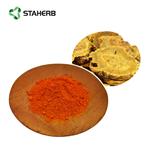 |
2024-04-09 | Emodin
518-82-1
|
US $0.00-0.00 / kg | 1kg | 50-95% | 1000kg | Changsha Staherb Natural Ingredients Co., Ltd. | |
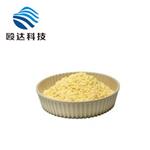 |
2024-03-13 | Emodin
518-82-1
|
US $0.00-0.00 / kg | 1kg | 99 | 1000kg | Shanghai Affida new material science and technology center | |
 |
2023-03-06 | Emodin
518-82-1
|
US $10.70 / g/Bag | 10g | 99% | 10000kg | Hebei Guanlang Biotechnology Co,.LTD |





